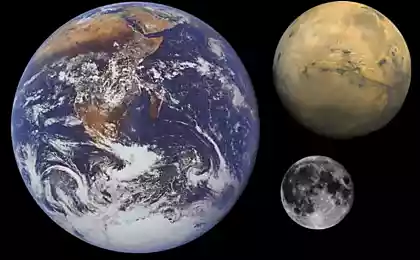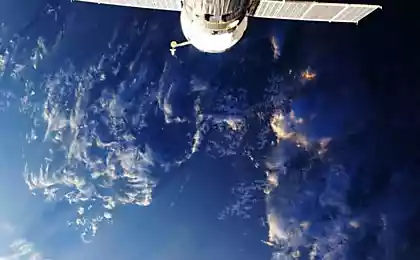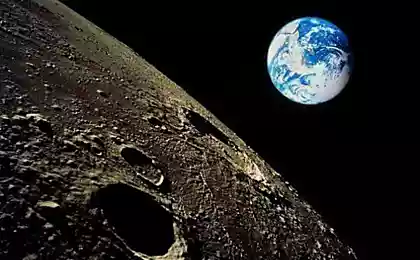1082
Russia is flying to the moon
After two years, will begin a new lunar expedition!
Water on the moon a few percent in the top layer of soil. Somewhere more, somewhere less. In the autumn it was published a detailed map of its distribution, compiled according to the device LEND, engineered by Russian scientists. Now it is preparing an expedition to the water in the polar regions. For the first thirty years of Russian flies to the moon.
Letters ph: + 7 via Daria Zolotukhin, Alexey Torgashev

- You will be convenient to us in the evening to come back later? And then we have these days are completely overwhelmed. Determine the landing on the moon - said by telephone Head of Laboratory Igor Mitrofanov. - According to our map of the distribution of water.
Space power Russia so long since traveled beyond the Earth's orbit, the news about the imminent landing of the machine on the moon, of course, spurs the imagination. And, of course, we went on a Friday night at the Space Research Institute and, of course, caught out there full house staff involved in both the Moon and other planets of the solar system.
Many lunar ice
To wall poster nailed buttons chip value of the average car. Brutally nailed, right through. But she did not die from it. "Died heroically in the fight against high voltage" - follows from the print on the sheet under the chip.
The board, the inscription and the actual wall, on which all this joy is present, are in the lab space gamma spectroscopy of the Moscow Institute of Space Research. Laboratory - a large room with technical and office tables, divided by partitions into several compartments.
On your office desk, as it should, paper and computers engineering - various electronics, including a detector for the future of the American rover. It is this metal box thirty centimeters in length by six months to go to Mars to look for water, and we, the journalists, of course, could not resist, they touched. So now, if life on Mars is found, we'll know whose it is bacteria. However, we were assured that necessarily wash the box before sending ...
A deceased chip was tested for another detector - LEND, which became part of American instruments apparatus LRO, successfully launched in 2009 and is now flying around the moon at an altitude of 50 kilometers. Naturally, LEND flew with another live pay-inside. His task is the same - to look for water on the Moon. About the lunar water we came to talk with the staff of the laboratory.
- This device is designed to search for water ice in the lunar soil, - says Igor Mitrofanov, head of the project. - He flies above the surface and sees a change in the composition of soil with a resolution of ten kilometers. Here is a map, so to speak, the humidity of the Moon, we have already built.
- And a lot of water found? - Ask.
- It is enough - a few percent.
When the Americans run our LEND device on board, about the ice on the moon, little was known. It was clear that it is primarily in the form of remnants of comets, which are already four billion years cut into our companion. There was a second assumption: that the water can be formed in the chemical reactions of the solar wind with the lunar soil, regolith. In any case, the ice on the Moon, Americans discovered during the mission "Clementine" in 1993-94 (January 25 1994). But everybody thought that if the water is somewhere and preserved in significant quantities, probably, in the eternal shadows of craters on the North and South Poles. It was not so.
- You see, black contours outlined the so-called permanently shadowed areas - Mitrofanov map shows the distribution of water on the moon. - In the polar regions of the sun is low on the horizon, so if there is a crater, over the crest of his rays never reach. We expected that ice substantially and there is found because elsewhere in the water was evaporated by heating. But it turned out that the water content is not particularly dependent on opacity.
The map shows the blue place where a lot of water, and the yellow and red - which is not enough. Brain usual correlates with earth image maps, and with him, the brain, it turns out that the moon downright oceans. In fact, the amount of frozen ice particles in the red areas differs from blue by a few percent. Indeed, blue areas does not coincide with craters. Scientists believe that the water in the illuminated areas are under a layer of soil. After regolith - a very good thermal insulator, so a dozen centimeters from the surface of the already hot sun cold space.
- How did you and fifty kilometers, these percentages think? - Ask.
- And believe - says Mitrofanov. - The principle of what? The instrument detects neutrons that are emitted from the lunar soil in the interaction of cosmic particles. The number of these neutrons depends on the composition of the soil, especially the amount of hydrogen. Because neutron colliding with an atom of hydrogen, loses half its energy, slows down and can be absorbed. That is, where a lot of hydrogen, neutron small. A hydrogen on the moon just to be in the composition of water ice.
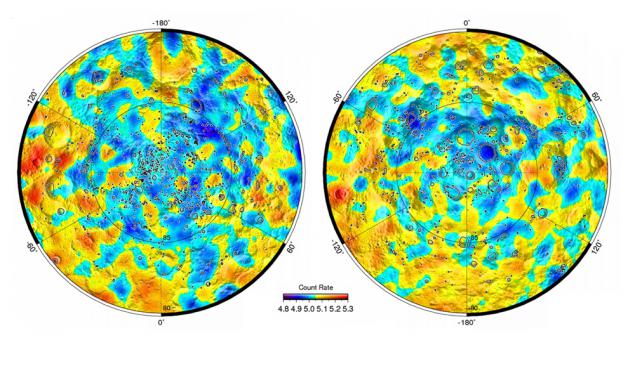
- And why the device was calling?
- Because the neutron is really small. We register only five neutrons per second. We made the most sensitive counters. Well ... Yes, that's Maxim ask it - the developer. Maxim, tell me how to do!
Mokrousov Maxim, a young man with confident movements and voice, pushed the table, which is an engineering sample LEND.
-ABOUT! - He says. - First, the development cycle of the device an average of five years, and LEND we developed very quickly, two and a half years. Secondly, in an ideal case, all tests are successfully. Here it was not so. There were a few failures, and in those circumstances, that seems to be a hundred times were: the two-day work, while the third - the refusal. To the sensitivity was high, we strengthen the weak currents. And here we have a breakdown spark, and due to increased high voltage came to the integrated circuit. It cuts down the brain. These boards are just so burnt, two pieces. Then he understood: it turned out, the varnish that covers the chip, begins to evaporate at high temperatures. And walking through the gas sample. It's no way to pinpoint, but to guess! - Maxim expressively pointing at his head.

Polar landing
When LEND accumulated statistics, to the delight of researchers, it became clear that water on the moon is present not only in the craters, but also in quite affordable and convenient for planting sunny plains. It was necessary to check whether it is water, and more precisely to say how much of it. Then the Americans conducted an experiment LCROSS. October 9, 2009 in the moon hit the upper stage "Centaurus". The blow knocked the cloud of dust from the surface to a height of one and a half kilometers away, and then the moon through the post "dropped" and the unit itself LCROSS, which is falling, to analyze the composition of lunar soil. All this happened on the border of the crater Cabeus at the South Pole. Water really found a lot - about 5% by weight.
- Now we need to choose a place to land our vehicles in 2013 and 2014. Well, look what a good area! Or ... - Mitrofanov points to little blue spots on the map. - In general, we offer a list of three or four areas that need more poizuchat two to three months. The soil, light conditions ...
First in 2013, will fly "Luna-Resource", followed by "Luna-Globe". Both missions are similar instrument, and the module soft landing all the same. The "Luna-Resource" - a joint project with India, which provides carrier rocket, orbiter and a small rover own design. But it is clear that our country fulfills the most difficult part - landing on the surface of the soil and contact investigations. "Luna-Globe" - a purely Russian expedition, and in general we were going to run it before "resources", but then, as it very often happens in our space industry, suffered first two years, followed by another two.
These two missions can be, generally speaking, be regarded as one with the provisional name "Russia is back". Because we are not planted on the moon sets since 1976, when the machine "Luna-24" delivered on Earth 170 grams of lunar soil. At that time, the country has exhausted the technical possibilities of the lunar program and reoriented to perfect complex "Energiya-Buran", later never found application. And now need to restore the position.
- Since I am personally responsible for the scientific part of the lander, with the objectives of the familiar well - said Mitrofanov. - The problem is this: a detailed study of the conditions in areas poles. Polar Moon, as we like to say - this is a new moon, not the one who has studied our rovers and US astronauts. The main difference is that it is at the poles in the ground is stored in the form of ice water and other volatile substances listed comets. The machines will be devices for remote analysis of dust plasma temperature below the surface. Ground lift arm into the device and examine its elemental and isotopic composition. Also, on the moon for the first time brought a beacon. And then you can very precisely to put other devices.
- Who can guarantee that you will get it in the area where at least some water is? Maybe it will be just a hundred meters away and brings you to the place where quite dry.
- No one. But we will choose the site with a homogeneous surface, and it is unlikely that there will be sharp differences on small scales. On the other hand, the question of the right, which is why the next step is to do a good long-lived rover and then return the soil. It is necessary to select and deliver not just any, but the most interesting examples. And certainly without defrosting, not to lose the volatile compounds. And if there are organic compounds, probably, first you need to deliver to the ISS to, God forbid, do not bring to the Earth something bad.
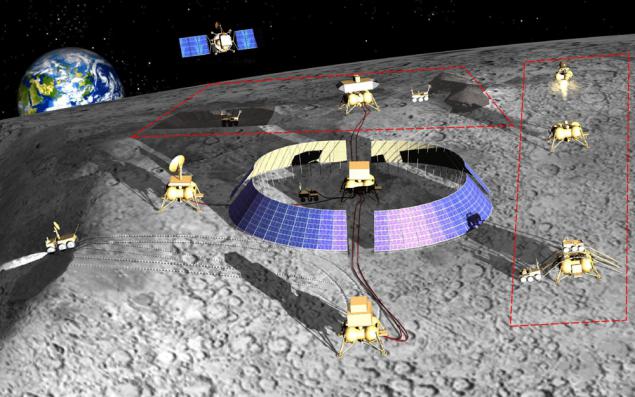
Lunar landfill
What Russia wants to do from the Moon in the coming years? What we have there is the problem beyond a simple "mark" and once again poizuchat ground? And, most importantly, how firmly we intend to carry out these tasks?
Such questions we asked Lukyanchikova Alexander, director of the Center for planetary exploration NPO. Lavochkin - an organization that creates devices for lunar missions. We met with him in the Museum of Cosmonautics Association: middle of the room as an exhibit rover - Oval trolley loaded devices on the first satellites, the unit had brought lunar soil, the map of the moon in the wall ... futuristic Soviet objects. And he Lukyanchikov - a stocky man in a suit and with cards in their hands, a classic Soviet engineer. On the maps of funny robots, both from children's coloring. Project our future lunar station or, as it is called, the landfill.
- After 2015, the Moon will begin the second phase of the program. In all likelihood, it will be shipping samples of lunar soil to Earth. But our ultimate goal - even though the final, probably will not happen ever, but still - the creation of "moon ground". In fact it is a lunar base, consisting of automatic modules - says Lukyanchikov. - Its infrastructure is a bit like a manned station. But the scale is much more modest, it does not require such huge costs to ensure viability of the astronauts, as projects 60-70s.
It is expected that there will be a means of transportation, a powerful power plant to supply arrangements, park rovers. Then it will be possible to deliver new modules from the Earth and expand the base.
- For example, there can be transported large-sized telescope for deep space exploration, the full-scale plant for the studies of the soil, - says Lukyanchikov. - However, the "moon landfill" is not registered in the current Federal Space Program, its validity - until 2015. But I think in five years or ten, we will create all the necessary building blocks for such a base.
- Do you plan to industrial development of the moon?
- There are different views on this issue. For example, an ardent supporter of the idea of using the moon for energy raw materials - a Vernadsky Institute of Geochemistry. I mean, the isotope helium-3 as a potential fuel for pure fusion reactor - explains Lukyanchikov. - If it comes to devices for the extraction, separation of this isotope, and its storage and so on, these devices we have not yet developed. Information about similar projects in other countries, we too are not.
While the rocket men build a base for robot, but build it from the water. This means that in the future will go to real people. Water is necessary for us and any greenhouses, greenhouses, which will be on the moon by all means, if it is manned base. Ice on the Moon allows you to put a simple apparatus for producing oxygen and hydrogen from water. Take the soil warms up, get steam. Water electricity decompose into oxygen and hydrogen - and once the air and fuel for rockets.
Those data obtained by scientists from the Institute of Space Studies show that a ton of local soil can be squeezed pyatidesyatilitrovy water tank. Not so bad. In some regions of the Earth's soil is much drier.
The very question - do we need a moon? - People involved in the space program, was settled long ago.
- I believe that the moon is bound to be mastered. Not studied and mastered it, that is included in the civilizational environment, - he told us Mitrofanov. - It will also be used as a platform for exploration of Mars. I think that inevitably arise regular traffic between the Earth and the Moon, and later between Earth and Mars. At the poles of the moon will attend outposts earthlings. I can not guarantee that there is always need to keep a crew, but the conditions are there for a visit.

- But there is also a good engine to cheaply raise the rocket from Earth! Print kilogram load at low orbit worth thousands of dollars! Is it possible in such conditions to travel en masse?
- We are now doing the project "Phobos-Grunt", it is worth five billion rubles, which is about a hundred rubles a working citizen of the country. It's not even the Moon, it is the orbit of Mars! A mass of travel let's not talk, let's just fly. We have 20 years did not send units into deep space. If we are not going to support the further space exploration, the answers to the questions will be certain: we will not be able to participate in lunar space program. Exactly what astronautics XXI century - the moon. Either we fly, or have to ask for the board.
The laboratory at the Institute of Space Studies filled devices and appliance, which over time will fly through the solar system. Hold in your hands a piece of metal, full of chips, and a year later he would go on to Mars.
- You do not have enough work here? - Ask.
- Well, get used to it!
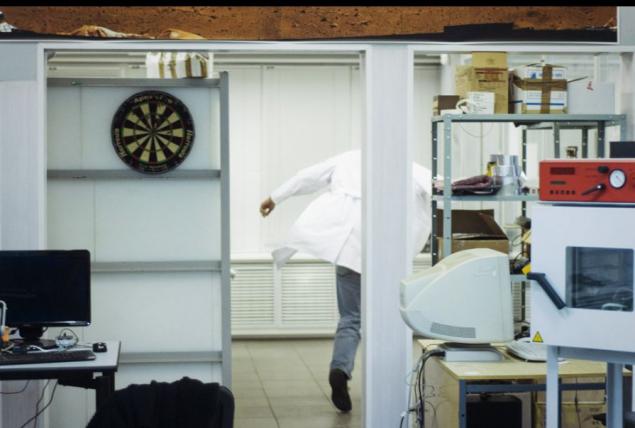
Chronology of space ambitions
Before any of the planets will get the interests of humanity in the next quarter of a century
2011
"Phobos-Grunt" (Russia) to leave the soil of Phobos robot spacecraft. So far, no country in the world trying to bring soil from the Martian satellite to Earth.
Mars Science Laboratory (Mars Science Laboratory), or Curiosity (in translation - "curiosity"), NASA. As is the case with the Russian "Phobos-Grunt", the launch of the device does not fit into the "window to Mars" in 2009, so was moved to 2011. The rover new generation, which is a stand-alone chemical laboratory must analyze the Martian soil and atmospheric constituents. And based on these data, the American scientists promise to establish whether there was ever life on Mars. Among devices, there are those that are made in our Institute for Space Research.
GRAIL (laboratory analysis of the gravity of subsoil) - NASA's new mission, which will investigate the unusual gravitational field of the moon. It is expected that the "Lunar Grail" will shed light on the history of the origin of the Moon, the Earth and other Earth-like planets.
2012
Mission Lunar Atmosphere and Dust Environment Explorer (LADEE) NASA to orbit the moon will leave the machine, which will study the atmosphere and dust around the planet.
2013
The second phase of China's lunar program: landing on the surface of the moon rovers. Machines can work and moonlit night due to the power of the radioisotope thermoelectric generators. Moon rovers are ready, but not yet developed vehicles and landers.
Project M (NASA) - sending robots to the moon - the avatars instead of people. Such a robot would move on commands sent from Earth, that is, copy the movements of a real person, Text which currently it is. It will be the first step in the creation of the American moon base.
Starting MAVEN (Mars Atmosphere and Volatile EvolutioN) - US probe designed to explore the reasons why Mars lost its atmosphere.
India will continue to lunar odyssey, this time in tandem with Russia.
Source:
Water on the moon a few percent in the top layer of soil. Somewhere more, somewhere less. In the autumn it was published a detailed map of its distribution, compiled according to the device LEND, engineered by Russian scientists. Now it is preparing an expedition to the water in the polar regions. For the first thirty years of Russian flies to the moon.
Letters ph: + 7 via Daria Zolotukhin, Alexey Torgashev

- You will be convenient to us in the evening to come back later? And then we have these days are completely overwhelmed. Determine the landing on the moon - said by telephone Head of Laboratory Igor Mitrofanov. - According to our map of the distribution of water.
Space power Russia so long since traveled beyond the Earth's orbit, the news about the imminent landing of the machine on the moon, of course, spurs the imagination. And, of course, we went on a Friday night at the Space Research Institute and, of course, caught out there full house staff involved in both the Moon and other planets of the solar system.
Many lunar ice
To wall poster nailed buttons chip value of the average car. Brutally nailed, right through. But she did not die from it. "Died heroically in the fight against high voltage" - follows from the print on the sheet under the chip.
The board, the inscription and the actual wall, on which all this joy is present, are in the lab space gamma spectroscopy of the Moscow Institute of Space Research. Laboratory - a large room with technical and office tables, divided by partitions into several compartments.
On your office desk, as it should, paper and computers engineering - various electronics, including a detector for the future of the American rover. It is this metal box thirty centimeters in length by six months to go to Mars to look for water, and we, the journalists, of course, could not resist, they touched. So now, if life on Mars is found, we'll know whose it is bacteria. However, we were assured that necessarily wash the box before sending ...
A deceased chip was tested for another detector - LEND, which became part of American instruments apparatus LRO, successfully launched in 2009 and is now flying around the moon at an altitude of 50 kilometers. Naturally, LEND flew with another live pay-inside. His task is the same - to look for water on the Moon. About the lunar water we came to talk with the staff of the laboratory.
- This device is designed to search for water ice in the lunar soil, - says Igor Mitrofanov, head of the project. - He flies above the surface and sees a change in the composition of soil with a resolution of ten kilometers. Here is a map, so to speak, the humidity of the Moon, we have already built.
- And a lot of water found? - Ask.
- It is enough - a few percent.
When the Americans run our LEND device on board, about the ice on the moon, little was known. It was clear that it is primarily in the form of remnants of comets, which are already four billion years cut into our companion. There was a second assumption: that the water can be formed in the chemical reactions of the solar wind with the lunar soil, regolith. In any case, the ice on the Moon, Americans discovered during the mission "Clementine" in 1993-94 (January 25 1994). But everybody thought that if the water is somewhere and preserved in significant quantities, probably, in the eternal shadows of craters on the North and South Poles. It was not so.
- You see, black contours outlined the so-called permanently shadowed areas - Mitrofanov map shows the distribution of water on the moon. - In the polar regions of the sun is low on the horizon, so if there is a crater, over the crest of his rays never reach. We expected that ice substantially and there is found because elsewhere in the water was evaporated by heating. But it turned out that the water content is not particularly dependent on opacity.
The map shows the blue place where a lot of water, and the yellow and red - which is not enough. Brain usual correlates with earth image maps, and with him, the brain, it turns out that the moon downright oceans. In fact, the amount of frozen ice particles in the red areas differs from blue by a few percent. Indeed, blue areas does not coincide with craters. Scientists believe that the water in the illuminated areas are under a layer of soil. After regolith - a very good thermal insulator, so a dozen centimeters from the surface of the already hot sun cold space.
- How did you and fifty kilometers, these percentages think? - Ask.
- And believe - says Mitrofanov. - The principle of what? The instrument detects neutrons that are emitted from the lunar soil in the interaction of cosmic particles. The number of these neutrons depends on the composition of the soil, especially the amount of hydrogen. Because neutron colliding with an atom of hydrogen, loses half its energy, slows down and can be absorbed. That is, where a lot of hydrogen, neutron small. A hydrogen on the moon just to be in the composition of water ice.

- And why the device was calling?
- Because the neutron is really small. We register only five neutrons per second. We made the most sensitive counters. Well ... Yes, that's Maxim ask it - the developer. Maxim, tell me how to do!
Mokrousov Maxim, a young man with confident movements and voice, pushed the table, which is an engineering sample LEND.
-ABOUT! - He says. - First, the development cycle of the device an average of five years, and LEND we developed very quickly, two and a half years. Secondly, in an ideal case, all tests are successfully. Here it was not so. There were a few failures, and in those circumstances, that seems to be a hundred times were: the two-day work, while the third - the refusal. To the sensitivity was high, we strengthen the weak currents. And here we have a breakdown spark, and due to increased high voltage came to the integrated circuit. It cuts down the brain. These boards are just so burnt, two pieces. Then he understood: it turned out, the varnish that covers the chip, begins to evaporate at high temperatures. And walking through the gas sample. It's no way to pinpoint, but to guess! - Maxim expressively pointing at his head.

Polar landing
When LEND accumulated statistics, to the delight of researchers, it became clear that water on the moon is present not only in the craters, but also in quite affordable and convenient for planting sunny plains. It was necessary to check whether it is water, and more precisely to say how much of it. Then the Americans conducted an experiment LCROSS. October 9, 2009 in the moon hit the upper stage "Centaurus". The blow knocked the cloud of dust from the surface to a height of one and a half kilometers away, and then the moon through the post "dropped" and the unit itself LCROSS, which is falling, to analyze the composition of lunar soil. All this happened on the border of the crater Cabeus at the South Pole. Water really found a lot - about 5% by weight.
- Now we need to choose a place to land our vehicles in 2013 and 2014. Well, look what a good area! Or ... - Mitrofanov points to little blue spots on the map. - In general, we offer a list of three or four areas that need more poizuchat two to three months. The soil, light conditions ...
First in 2013, will fly "Luna-Resource", followed by "Luna-Globe". Both missions are similar instrument, and the module soft landing all the same. The "Luna-Resource" - a joint project with India, which provides carrier rocket, orbiter and a small rover own design. But it is clear that our country fulfills the most difficult part - landing on the surface of the soil and contact investigations. "Luna-Globe" - a purely Russian expedition, and in general we were going to run it before "resources", but then, as it very often happens in our space industry, suffered first two years, followed by another two.
These two missions can be, generally speaking, be regarded as one with the provisional name "Russia is back". Because we are not planted on the moon sets since 1976, when the machine "Luna-24" delivered on Earth 170 grams of lunar soil. At that time, the country has exhausted the technical possibilities of the lunar program and reoriented to perfect complex "Energiya-Buran", later never found application. And now need to restore the position.
- Since I am personally responsible for the scientific part of the lander, with the objectives of the familiar well - said Mitrofanov. - The problem is this: a detailed study of the conditions in areas poles. Polar Moon, as we like to say - this is a new moon, not the one who has studied our rovers and US astronauts. The main difference is that it is at the poles in the ground is stored in the form of ice water and other volatile substances listed comets. The machines will be devices for remote analysis of dust plasma temperature below the surface. Ground lift arm into the device and examine its elemental and isotopic composition. Also, on the moon for the first time brought a beacon. And then you can very precisely to put other devices.
- Who can guarantee that you will get it in the area where at least some water is? Maybe it will be just a hundred meters away and brings you to the place where quite dry.
- No one. But we will choose the site with a homogeneous surface, and it is unlikely that there will be sharp differences on small scales. On the other hand, the question of the right, which is why the next step is to do a good long-lived rover and then return the soil. It is necessary to select and deliver not just any, but the most interesting examples. And certainly without defrosting, not to lose the volatile compounds. And if there are organic compounds, probably, first you need to deliver to the ISS to, God forbid, do not bring to the Earth something bad.

Lunar landfill
What Russia wants to do from the Moon in the coming years? What we have there is the problem beyond a simple "mark" and once again poizuchat ground? And, most importantly, how firmly we intend to carry out these tasks?
Such questions we asked Lukyanchikova Alexander, director of the Center for planetary exploration NPO. Lavochkin - an organization that creates devices for lunar missions. We met with him in the Museum of Cosmonautics Association: middle of the room as an exhibit rover - Oval trolley loaded devices on the first satellites, the unit had brought lunar soil, the map of the moon in the wall ... futuristic Soviet objects. And he Lukyanchikov - a stocky man in a suit and with cards in their hands, a classic Soviet engineer. On the maps of funny robots, both from children's coloring. Project our future lunar station or, as it is called, the landfill.
- After 2015, the Moon will begin the second phase of the program. In all likelihood, it will be shipping samples of lunar soil to Earth. But our ultimate goal - even though the final, probably will not happen ever, but still - the creation of "moon ground". In fact it is a lunar base, consisting of automatic modules - says Lukyanchikov. - Its infrastructure is a bit like a manned station. But the scale is much more modest, it does not require such huge costs to ensure viability of the astronauts, as projects 60-70s.
It is expected that there will be a means of transportation, a powerful power plant to supply arrangements, park rovers. Then it will be possible to deliver new modules from the Earth and expand the base.
- For example, there can be transported large-sized telescope for deep space exploration, the full-scale plant for the studies of the soil, - says Lukyanchikov. - However, the "moon landfill" is not registered in the current Federal Space Program, its validity - until 2015. But I think in five years or ten, we will create all the necessary building blocks for such a base.
- Do you plan to industrial development of the moon?
- There are different views on this issue. For example, an ardent supporter of the idea of using the moon for energy raw materials - a Vernadsky Institute of Geochemistry. I mean, the isotope helium-3 as a potential fuel for pure fusion reactor - explains Lukyanchikov. - If it comes to devices for the extraction, separation of this isotope, and its storage and so on, these devices we have not yet developed. Information about similar projects in other countries, we too are not.
While the rocket men build a base for robot, but build it from the water. This means that in the future will go to real people. Water is necessary for us and any greenhouses, greenhouses, which will be on the moon by all means, if it is manned base. Ice on the Moon allows you to put a simple apparatus for producing oxygen and hydrogen from water. Take the soil warms up, get steam. Water electricity decompose into oxygen and hydrogen - and once the air and fuel for rockets.
Those data obtained by scientists from the Institute of Space Studies show that a ton of local soil can be squeezed pyatidesyatilitrovy water tank. Not so bad. In some regions of the Earth's soil is much drier.
The very question - do we need a moon? - People involved in the space program, was settled long ago.
- I believe that the moon is bound to be mastered. Not studied and mastered it, that is included in the civilizational environment, - he told us Mitrofanov. - It will also be used as a platform for exploration of Mars. I think that inevitably arise regular traffic between the Earth and the Moon, and later between Earth and Mars. At the poles of the moon will attend outposts earthlings. I can not guarantee that there is always need to keep a crew, but the conditions are there for a visit.

- But there is also a good engine to cheaply raise the rocket from Earth! Print kilogram load at low orbit worth thousands of dollars! Is it possible in such conditions to travel en masse?
- We are now doing the project "Phobos-Grunt", it is worth five billion rubles, which is about a hundred rubles a working citizen of the country. It's not even the Moon, it is the orbit of Mars! A mass of travel let's not talk, let's just fly. We have 20 years did not send units into deep space. If we are not going to support the further space exploration, the answers to the questions will be certain: we will not be able to participate in lunar space program. Exactly what astronautics XXI century - the moon. Either we fly, or have to ask for the board.
The laboratory at the Institute of Space Studies filled devices and appliance, which over time will fly through the solar system. Hold in your hands a piece of metal, full of chips, and a year later he would go on to Mars.
- You do not have enough work here? - Ask.
- Well, get used to it!

Chronology of space ambitions
Before any of the planets will get the interests of humanity in the next quarter of a century
2011
"Phobos-Grunt" (Russia) to leave the soil of Phobos robot spacecraft. So far, no country in the world trying to bring soil from the Martian satellite to Earth.
Mars Science Laboratory (Mars Science Laboratory), or Curiosity (in translation - "curiosity"), NASA. As is the case with the Russian "Phobos-Grunt", the launch of the device does not fit into the "window to Mars" in 2009, so was moved to 2011. The rover new generation, which is a stand-alone chemical laboratory must analyze the Martian soil and atmospheric constituents. And based on these data, the American scientists promise to establish whether there was ever life on Mars. Among devices, there are those that are made in our Institute for Space Research.
GRAIL (laboratory analysis of the gravity of subsoil) - NASA's new mission, which will investigate the unusual gravitational field of the moon. It is expected that the "Lunar Grail" will shed light on the history of the origin of the Moon, the Earth and other Earth-like planets.
2012
Mission Lunar Atmosphere and Dust Environment Explorer (LADEE) NASA to orbit the moon will leave the machine, which will study the atmosphere and dust around the planet.
2013
The second phase of China's lunar program: landing on the surface of the moon rovers. Machines can work and moonlit night due to the power of the radioisotope thermoelectric generators. Moon rovers are ready, but not yet developed vehicles and landers.
Project M (NASA) - sending robots to the moon - the avatars instead of people. Such a robot would move on commands sent from Earth, that is, copy the movements of a real person, Text which currently it is. It will be the first step in the creation of the American moon base.
Starting MAVEN (Mars Atmosphere and Volatile EvolutioN) - US probe designed to explore the reasons why Mars lost its atmosphere.
India will continue to lunar odyssey, this time in tandem with Russia.
Source:












